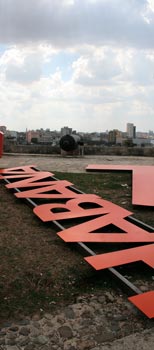Next May 11th the eleventh edition of the Havana Biennialwill be opened, the largest and most complex visual arts event in Cuba, founded in 1984 under the management of the Contemporary Art Centre Wifredo Lam and the Ministry of Culture.
Since its first summons it set out to be the ideal meeting place for research and diffusion of emblematic creation of Latin America and the Caribbean, Asia and Africa; a stage for the confrontation of artistic expression of these regions without hierarchy or discrimination, embracing at the same time crafts and all popular expressions of visual culture such as architecture, design and the sophisticated works created by means of innovative technology in the universe of video, computers and digitalization.
 Bursting into many spaces of Old and modern Havana, the Biennial transforms the capital into a gigantic gallery where renowned artists come together and younger talents in solo exhibitions, group projects, workshops, theoretical discussions... To each edition experts from all latitudes, collectors, gallery owners, directors of institutions, and journalists also assist to examine and get a firsthand look at an important part of the art produced in the most populated regions of the planet.
Bursting into many spaces of Old and modern Havana, the Biennial transforms the capital into a gigantic gallery where renowned artists come together and younger talents in solo exhibitions, group projects, workshops, theoretical discussions... To each edition experts from all latitudes, collectors, gallery owners, directors of institutions, and journalists also assist to examine and get a firsthand look at an important part of the art produced in the most populated regions of the planet.
On this occasion, the Havana Biennial will take place under international circumstances in which debates on contemporary art scenarios have been substantially modified and have acquired new meanings, both for artists as well as for institutions and diverse audiences.
The works presented intend to reflect on the way that the relationships between visual creations and social imagery behave. Presently, the concept of public incorporates transverse scenarios in its dialogic dimension, which makes the public sphere in the main axis of exchange associated to new configurations of social imagination; and this process takes on again a special connotation, where the role of art and its creative practices are essential. Previous editions of the Havana Biennial took on as an object of curatorial interest emerging experiences of this phenomenon.
The Biennial aims to emphasize the role of art in the transformation of objects and as a catalyst of social subjects. The Biennial seeks to explore the dissimilar meanings of public taking into account the typical interventions in urban spaces, interactive projects, ludic, multidisciplinary; social integration and community work processes, and the media that has gradually expanded the levels of accessibility to technology and current forms of communication.
One of the main objectives of the event is aimed to make you think about the basis on which social networks are formed and become social spaces between people from different parts of the world, in which the most intimate profiles of human beings are diluted and put to test.
In the meantime art has not been oblivious to environmental degradation or the crises that have been generated in large cities; this new situation leads us to rethink the configuration of urban models based on the emerging needs for survival. Environmental education is once again today the motivation that mobilizes broad sectors of civil society worldwide.
As a result of these considerations, for the Eleventh Havana Biennial dialogue between the inside and the outside will be essential, working with live art and permanently involving the viewer..., turning the Cuban context and public stages of Havana into a temporary laboratory of artistic experimentation.
Some of the guests at the event will be: Emilia and Ilya Kabakov (Russia); Hermann Nitsch (Austria); Gabriel Orozco and Rafael Lozano-Hemmer (Mexico); Jean-François Bocle (Martinique); Kcho, The Carpenters, Carlos Garaicoa and DUPP Gallery (Cuba); the Quintapata collective (Dominican Republic) and Marcel Pinas (Suriname). There are over one hundred artists enrolled, who will display their works at the Pabellon Cuba, in El Vedado; the García Lorca Theater; the galleries: Acacia, Origins and Collage Havana, in the heart of the city; as well as the Wifredo Lam Center, the Photo Library of Cuba, the House of Mexico and the House of Guayasamín, all located in Old Havana.
The joint projects this time include the community experience MACSAN (Contemporary Art Museum of San Agustin, west of the city), La caza del éxito(Hunting success, exhibition about the changes in the architecture and the environment of our cities by the new economic conditions in Cuba and Central America), Open Score (a group of artists working on technological advances in the field of digitalization) and the collective project Detrás del Muro (Behind the Wall, public interventions and works installed on a stretch of Havana’s Malecón), among others.
 In the same manner, the public will enjoy works by teachers and students of the San Alejandro Academy of Fine Arts and the Higher Institute of Arts, located on the west side of the city.
In the same manner, the public will enjoy works by teachers and students of the San Alejandro Academy of Fine Arts and the Higher Institute of Arts, located on the west side of the city.
Complementing these core areas with proposals from artists of all latitudes, will be the series of Cuban art exhibitions may be viewed at the vast network of galleries and institutions in Havana during the 30 days of the event.
The Havana Biennial is undoubtedly a singular happening within the overall global panorama of events going on in the world today. A unique opportunity to feel the changes that are taking place within contemporary art practices and how these transform our perception of culture in images.
Related Publications

How Harumi Yamaguchi invented the modern woman in Japan
March 16, 2022
Giovanni Duarte and an orchestra capable of everything
August 26, 2020











